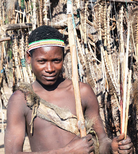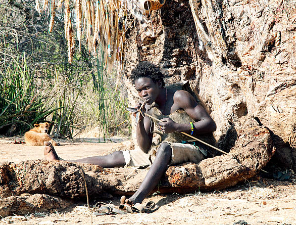Hadza, also known as the Hadzabe, are among the last true hunter-gatherers on Earth. Residing in the remote regions of northern Tanzania, they have preserved a lifestyle that has remained largely unchanged for thousands of years. This unique tribe offers insights into how early humans lived, hunted, and thrived in the wild. This article explores the fascinating world of the Hadza, their way of life, culture, challenges, and the lessons they offer to modern society.
Who Are the Hadza?

The Hadza are an indigenous ethnic group living around Lake Eyasi, located near the Great Rift Valley in Tanzania. With an estimated population of around 1,300 to 1,500, they have managed to sustain a lifestyle that is free from agriculture, domesticated animals, and permanent settlements. Unlike most modern societies, the Hadza rely solely on hunting wild game, foraging for plants, and gathering honey.
The Hadza Hunter-Gatherer Lifestyle

Hadza tribe lifestyle is simple yet highly effective. They hunt games such as antelope, baboons, and birds using hand-made bows and arrows. Their diet also includes wild tubers, berries, and honey, which they gather from the surrounding forests. Hunting is a communal activity, and men usually hunt in small groups, while women focus on gathering fruits, tubers, and other edible plants.
One remarkable aspect of the Hadza’s hunting techniques is their deep knowledge of the environment. They can identify various animal tracks, know which plants are edible, and have developed unique methods to extract honey from beehives. This close relationship with nature allows them to survive even in harsh environments, making them experts in sustainable living.
Hadza Society The Role of Women

Women play a crucial role in Hadza society. While the men hunt, women gather a significant portion of the daily food, ensuring the community’s survival. They are skilled in identifying edible plants, roots, and berries. Women’s role in the Hadza culture emphasizes equality, as their contribution to food gathering is just as essential as the men’s hunting efforts. Unlike many patriarchal societies, the Hadza have a more balanced gender dynamic, where cooperation and mutual respect are essential for survival.
The Hadza Unique Social Structure

Hadza tribe’s social structure is fascinating because it lacks the rigid hierarchies seen in many other cultures. There are no formal leaders, chiefs, or kings. Decisions are made collectively, and individuals are free to act independently without pressure. This non-hierarchical approach allows for a sense of freedom and individuality that is rare in modern societies. Despite the absence of rigid leadership, the Hadza maintain a cohesive community that works together to sustain their way of life.
The Hadza Language and Communication

The Hadza tribe speak a unique language, which belongs to the Khoisan language family. It is characterized by a series of click sounds, making it one of the few surviving click languages in the world. This distinct language is an essential part of their cultural identity, helping to preserve their traditional knowledge, stories, and practices. However, the language is at risk as younger generations are increasingly exposed to Swahili, the national language of Tanzania.
The Hadza Challenges Facing

While the Hadza have managed to maintain their traditional lifestyle for thousands of years, they now face numerous challenges that threaten their way of life. Encroachment on their land by agricultural expansion, tourism, and government policies has significantly reduced the areas where they can hunt and gather. Additionally, climate change and resource depletion are making it more difficult for them to sustain their traditional lifestyle.
There have been efforts to help the Hadza adapt to modern challenges while preserving their culture. Various NGOs and local organizations are working to protect their land rights, support sustainable tourism, and raise awareness about the importance of preserving Hadza’s cultural heritage. However, balancing the need for conservation with the pressures of modernization remains a complex issue.
The Hadza and Sustainability: Lessons for Modern Society

The Hadza’s way of life offers valuable lessons on sustainability and coexistence with nature. Unlike modern societies, which often prioritize economic growth at the expense of the environment, the Hadza have lived sustainably for millennia by taking only what they need from nature. Their diet, which is rich in diverse nutrients, and their lifestyle, which emphasizes physical activity, can also offer insights into healthier living.
The Future of the Hadza
The future of the Hadza is uncertain. With ongoing challenges like land disputes, climate change, and the pressures of modernization, there are concerns that their way of life could disappear. Efforts to document their knowledge, language, and culture are crucial to preserving their legacy. Additionally, initiatives to promote sustainable tourism can help generate income for the Hadza without disrupting their traditional practices.
How to Visit and Experience Hadza Culture Respectfully

For those interested in learning more about the Hadza and experiencing their way of life, it is possible to visit their communities The following tips pertain to travelling responsibly:
near Lake Eyasi. However, it is important to approach such visits with respect and sensitivity. Following advice related to responsible travel:
- Choose Ethical Tour Operators: Select tour companies that prioritize the well-being of the Hadza community and work directly with them to ensure fair compensation.
- Respect Their Traditions: While observing the Hadza’s lifestyle, avoid intrusive behaviour. Photography should only be done with permission, and visitors should be mindful of not disrupting their daily routines.
- Support Local Initiatives: Consider contributing to local projects that aim to protect the Hadza’s land rights and promote cultural preservation.
Conclusion

The Hadza are more than just a relic of the past; they are a living example of humanity’s roots, showcasing how people can live harmoniously with nature. As the world grapples with issues of sustainability, climate change, and environmental degradation, there is much to learn from the Hadza. Preserving their culture and way of life is not just about protecting a community but also about understanding the principles of sustainability that have allowed them to thrive for thousands of years. By supporting efforts to protect their rights and raise awareness about their unique culture, we
can help ensure that the Hadza continue to be a part of our shared human heritage.
